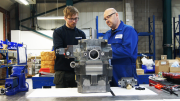 Hydraulic systems are used throughout heavy industry to deliver power and control to a wide range of processes. Keeping all the components operational and reliable requires a considerable level of expertise and maintenance facilities. David Atkinson, Leeds Service Centre Manager for Oilgear, explains the essential requirements for a successful maintenance partnership.
Hydraulic systems are used throughout heavy industry to deliver power and control to a wide range of processes. Keeping all the components operational and reliable requires a considerable level of expertise and maintenance facilities. David Atkinson, Leeds Service Centre Manager for Oilgear, explains the essential requirements for a successful maintenance partnership.
Steel manufacturing, power generation, forging, oil and gas all have their own unique requirements for hydraulic power, but common to all of them is the need for reliability and efficiency. Common practice within these industries is to operate shut-down periods where the bulk of major maintenance and repair work is completed. However, while this system maximises productivity, it also puts considerable pressure of the maintenance providers who must deliver all the projects on time.
It is therefore very important to carefully select these maintenance partners and ensure that they have sufficient expertise and resources to deliver the needs of the business. Clearly equipment which is relatively new will be supported by the original equipment manufacturer (OEM), often through a service agreement, but the majority of process infrastructure can be maintained independently.
Those responsible for the continued maintenance of hydraulic assets within a business need to assess their requirements and the best way to meet them. Once an initial service agreement has expired, there are a number of choices in terms of continued maintenance cover.
Maintaining the status quo for a particular asset means continuing to take advantage of the OEM’s expertise and ability to provide spare parts and technical support in a short timeframe. However, applying this principle across a large number of different assets could result in a complex maintenance scheme involving a large number of suppliers.
One alternative would be to engage an independent maintenance provider with the skills and resources to repair all of the on-site hydraulic assets. This simplifies the management of the maintenance programme but there is a risk that some technical projects requiring the expertise of an OEM may not be delivered.
This leaves the middle ground, that is to say, the OEM that also has invested more heavily than some in its on-site maintenance capabilities to the point that it is capable of delivering high quality repairs on any hydraulic asset. There are a number of providers in this field so further research is always advisable.
An OEM will have considerable design and testing resources that are used in the original manufacturing process and these can also be used to support a field service team. Furthermore, greater resources will also apply to the quantity of spare parts or exchange components that can be held for a customer. All of these attributes will help to reduce the amount of downtime within a business.
For example, Oilgear has been manufacturing hydraulic components for more than 95 years. Over this time the company has built up a vast bank of experience that can be used to support other systems. In addition, the company’s design capacity can be used to reverse engineer obsolete parts or to create improved parts through an asset improvement programme.
Furthermore, the design capabilities of an OEM can be used for the benefit of equipment from other manufacturers. Hydraulic design engineers can carry out all the necessary measurements to determine the original specification of a failed pump and make sure that the repairs return the component to as-new condition.
At the same time, it may be possible to introduce improvements in the design, by using alternative materials or manufacturing processes. This can also be applied to the control of hydraulic equipment and ensuring that it is operating as efficiently as possible.
With the focus firmly on energy efficiency, the ability to reduce the energy requirements of a process has become even more critical. Power optimisation is more important than ever, and maintenance providers that can implement improved designs with minimal disruption to productivity can offer excellent return on investment.
Having established the ability to complete effective and timely repairs, as well as the capacity to improve efficiency, the final step is to manage on-going reliability. One of the most effective methods is predictive maintenance which assesses trends within continuous data from pressure, temperature, flow, vibration and noise sensors to determine the expected service life of essential components.
On-site maintenance has to deal with a wide range of demands and it is essential that the provider of these services can deliver on time and to the highest quality standards. Flexibility, speed, reliability and attention to detail should form the pillars of any successful maintenance project, either short-term or long-term.
YouTube share link: https://youtu.be/8NtnoeFRp3U

